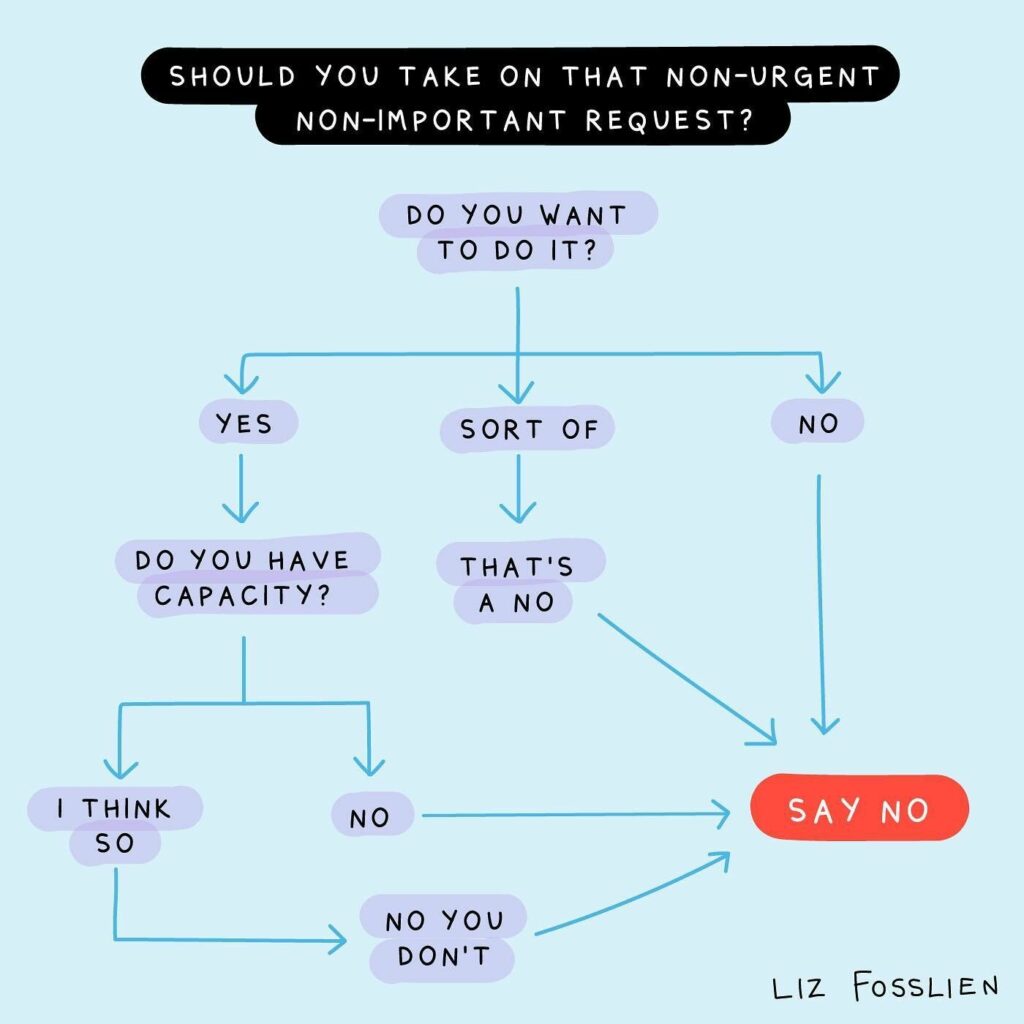How to Master Boundaries: 5 Essential Steps for a More Balanced Life

Ever feel like your work-life balance is more like work-work balance? Yep, us too. If you’re experiencing work-work overload then it’s a sign that your boundaries aren’t showing (enough).
We’ve long thought that work-life balance is a red herring, an impossible threshold for any of us to attain. The very phrase implies work or life, when the reality is we have one life, of which work is simply a (major) part. We all get the same allocation of 168 hours a week, for as many weeks as we have on this planet, it’s what we choose to put into these 168 hours that we can influence. This is where boundaries come in.
For our eagle-eyed readers, you’ll know that the foundational practice of an Ally Mindset is Abundance & Generosity. You may be saying “Yes! But how can you model Abundance & Generosity whilst having boundaries?”. We would argue, “How can you not?”
As Morag shares in our book You, Me, We, her default operating system for the world is Abundance & Generosity. She has shared how this can be both a blessing and a curse. It’s a blessing because she can move swiftly from one thing to another, soak up experiences, and be (mostly) in the moment. It becomes a curse when she says “yes” one time too many, without considering the impact on her other commitments, or more importantly, the impact of that yes on her personal psyche and fitness.
This is where boundaries come in—knowing what is important to you can be a powerful lens for identifying the things you should consider saying no to, so that you can save space for the HECK YES’S.
One point we want to reemphasize here is that boundaries aren’t about keeping others in line; they’re about understanding and communicating our own needs so we can bring our best selves to work and life.
Picture a boundary not as a rigid sea wall, but more like a beach with high tide and low tide markers. The tides shift, and so can our boundaries. Sometimes you stand firm, sometimes you let the waves wash over, and sometimes you adjust where the markers sit. And remember, “no” is a full answer. You don’t need to justify your boundaries, though it’s important to be sensitive to the needs of others to make informed choices about when or where to flex.
This image of beach warning flags is another great example of how boundaries can shift based on context. For instance, “I don’t work evenings or weekends” might be a boundary you choose, however you may also choose to flex that boundary if it’s your boss asking you to work late, or if there is a crisis that needs everyone to roll up their sleeves and solve together.

The issue with boundaries (or the lack of them) arises when the expectation is set that you will always work weekends, that you will always be on call to respond to every emergency. That’s when we can feel taken for granted, resentful of what we are being asked to do, or have ‘volunteered’ to do.
And did you notice the small print at the bottom of the sign? “An absence of flags does not assure safe waters.” This could easily be translated to, “An absence of stated boundaries does not mean I’m always available / not overwhelmed / happy to give up my weekend”
Boundaries matter. For you, and for those who around you. Here are three steps to set and fly your own boundary flags:
Look Up: Signs that you may need to set boundaries
Here are five signs that leaders we’re coaching have shared with us that highlight the importance of recognizing when your work-life balance is off and the need to set boundaries to protect your well-being and personal life..
- You’re Complaining About Work More Than You Celebrate It: If the majority of your conversations about work are complaints rather than achievements, it’s a sign that your work-life balance might be off.
- Skipped the Gym – Again: If your exercise routine or other personal care activities are constantly being sacrificed for work, it’s time to reassess your priorities and set some boundaries.
- Missed a Family or Social Engagement: Regularly missing important family events or social gatherings due to work commitments indicates that boundaries need to be established to protect your personal time.
- Feeling Obliged to Work Late: If you consistently feel pressured to stay late at the office or bring work home, it’s a clear sign that you need to set boundaries around your working hours.
- Fielding Calls or Emails Late Into the Evening: If you find yourself constantly responding to work communications after hours, it’s essential to set limits to ensure you have time to unwind and recharge.

Show Up: Choosing which boundaries to set
Much like the swimming flags you may have different threshold boundaries based on the context and ask being made of you. The key is to consider in advance what you want your ‘line in the sand to be’ so that you can then make a choice about whether or not YOU will cross it (remember boundaries are for you, not a rule for others)
- Reduce After-Hours Responses: Switch your phone to silent, resist responding during certain hours.
- Scheduled Breaks: Instead of accepting the back-to-back triple booked work day, choose to schedule at least a 30-minute break away from your desk every day. This white space then gives you the choice, to go for a walk, or to stay glued to your seat and working through.
- Meeting Limits: Set boundaries around meeting times, especially those meetings that you host. Use the auto scheduling that books 50 minutes instead of a hour, being clear as to who must attend and who is optional.
- Reprioritize Your Deprioritized List: For example, Morag’s fitness and gym routine was deprioritized for nearly 10 years. She made a choice to reprioritize and now schedules gym time during the workday (quelle horror!!) and now work fits around and INCLUDES her personal fitness. A win-win.
- Set Boundaries Around Interruptions: Establish specific times during the day when you’re available for drop-in questions or discussions, and communicate this to your team. This helps you stay focused during other times and reduces constant interruptions.
For many years Morag would proudly share that “She didn’t work on Saturdays”. It was a clear boundary that kept some time aside for anything and everything not SkyeTeam related. However expanding that to now ‘rarely working on weekends’ has opened up so many more opportunities. The reality is (as an entrepreneur) the work and to-do list will always expand to exceed the time available. Therefore setting boundaries that take back our time, that help prioritize all of the things we could do, to focus on the things we should do, mean that our work days, and life days, are more evenly balanced.
Step Up: Tips for Communicating and Maintaining Boundaries
While our philosophy is that boundaries are guidance for you and information for others, a boundary shared is one that can be more easily accommodated. Communicating your boundaries clearly—essentially waving your flag—means others are less likely to misunderstand your actions and more likely to respect your needs. Start small, no need to build a fully fledged castle with ramparts, instead consider the mental, emotional, and physical boundaries that you may need to communicate. Here are five simple tips for effectively sharing and maintaining your boundaries:
- Email Signature Note: Include a message in your email signature, such as: “If I’m sending this email outside of work hours, it’s because I am working flexibly. I don’t expect you to read, respond, or to action it outside of your usual/regular hours.”
- Set Clear Expectations in Meetings: During team meetings, discuss and agree on response times for emails and messages. For instance, aim to respond to emails within 24 hours and Slack messages within the same business day, unless marked urgent.
- Out-of-Office Messages: Use automatic responses to set expectations when you’re unavailable (and not just for vacations!). For example: “Thank you for your message. I am currently out of the office and will not be checking emails regularly. I will respond to your email within 24 hours of my return. For urgent matters, please contact [alternate contact person].”
- “Yes, But No” Strategy: When you need to decline a request but want to offer some support, try this: “I can’t take on the entire project right now, but I can help with the initial planning phase.” This shows willingness to contribute without overcommitting.
- Occasional “Yes” with Limits: Agree to a request but set clear boundaries for the future: “I can help out this weekend, but I won’t be able to do this regularly. Let’s find a more sustainable solution for next time.” This sets expectations and prevents recurring overcommitment.
By clearly communicating your boundaries, you empower yourself to thrive while helping others understand and respect your limits. Next time your manager asks for that report at 9 PM on a Friday, you’ll be ready. Maybe you’ll stand firm, maybe you’ll flex a bit, or maybe you’ll have a conversation about expectations. Whatever you choose, know that it’s your call.
Boundaries shift like the tides, and finding the balance that works for you is key. Let’s make our boundaries work for us, not against us.
Stay balanced, folks!

Let's Connect





